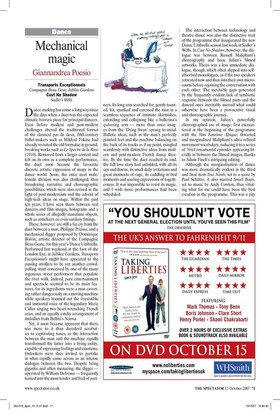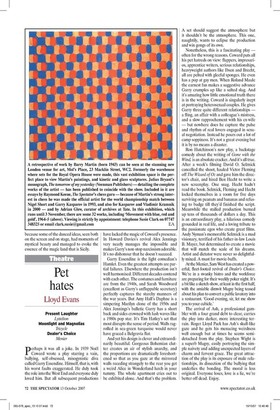Mechanical magic
Giannandrea Poesio Transports Exceptionnels Compagnie Beau Geste, Jubilee Gardens Cast No Shadow Sadler's Wells Dance-making has come a long way since the days when a duet was the expected climatic bravura piece for principal dancers. Even before modern and post-modern challenges altered the traditional format of the classical pas de deux, 20th-century ballet-makers such as Mikhail Fokine had already revisited the old formulae in groundbreaking works such as Le Spectre de la Rose (1910). Removed from a larger context and left on its own as a complete performance, the duet soon became the favourite discrete artistic expression of many in the dance world. Soon, the once neat male/ female division was also challenged, thus broadening narrative and choreographic possibilities, which were also revised in the light of post-modernism and the advent of high-tech ideas on stage. Within the past ten years, I have seen duets between real dancers and film images, holograms and a whole series of allegedly inanimate objects, such as armchairs or even sanitary fittings.
These, however, are still a far cry from the duet between a man, Philippe Priasso, and a mechanical digger proposed by Dominique Boivin, artistic director of the Compagnie Beau Geste, for this year's Dance Umbrella. Performed last weekend at the foot of the London Eye, in Jubilee Gardens, Transports Exceptionnels might have appeared to the passing strollers to be yet another crowdpulling stunt conceived by one of the many ingenious street performers that populate the river walk. Indeed, pure entertainment and spectacle seemed to be its main features, for its ingredients were a man cavorting rather dangerously on a moving machine while speakers boomed out the irresistible and immortal voice of the legendary Maria Callas singing two heart-wrenching French arias, and an equally catchy arrangement of melodies from Bellini's Norma.
Yet, it soon became apparent that there was more to it than daredevil acrobatics to captivating tunes, as the interaction between the man and the machine rapidly transformed the latter into a living entity, capable of expressing feelings and emotions. Onlookers were thus invited to partake in what rapidly came across as an intense dialogue between the two. Despite being gigantic and often menacing, the digger — operated by William Defresne — frequently turned into the most tender and frail of partners. Its long arm searched for, gently taunted, hit, spanked and caressed the man in a seamless sequence of intimate skirmishes, extending and collapsing like a ballerina's quivering arm — more than once images from the 'Dying Swan' sprang to mind. Balletic ideas, such as the man's perfectly pointed feet and the machine balancing on the back of its tracks as if on point, mingled seamlessly with distinctive ideas from modern and post-modern French dance theatre. By the time the duet reached its end, the full love story had unfolded, with all its ups and downs, its small daily irritations and great moments of rage, its cuddling-in-bed moments and soaring expressions of togetherness. It was impossible to resist its magic, and I wish more performances had been scheduled.
The interaction between technology and theatre dance was also the distinctive trait of the programme that inaugurated the new Dance Umbrella season last week at Sadler's Wells. In Cast No Shadow, however, the dialogue was between Russell Maliphant's choreography and Isaac Julien's filmed artworks. Theirs was a less immediate dialogue, though, which often slipped into selfabsorbed monologues, as if the two speakers retreated now and then into their own microcosms before rejoining the conversation with each other. The inevitable gaps generated by the frequently evident lack of symbiotic response between the filmed parts and the danced ones inevitably marred what could otherwise have been a provocative visual and choreographic journey.
In my opinion, Julien's powerfully choreographed use of image, first encountered at the beginning of the programme with the film Fantome Afrique, thwarted and marginalised Maliphant's ultra-refined movement vocabulary, reducing it to a series of brief ornamental episodes appearing literally in between the filmed images, thanks to Adam Finch's intriguing editing.
Although the marginalisation of dance was more dramatically evident in the third and final item True North, set to a score by Paul Schulze, it also marred Small Boats, set to music by Andy Cowton, thus vitiating what for me could have been the best creation in the programme. This was a pity because some of the danced ideas, seen both on the screen and on stage, had moments of mystical beauty and managed to evoke the essence of the magic land that is Sicily.




































































 Previous page
Previous page